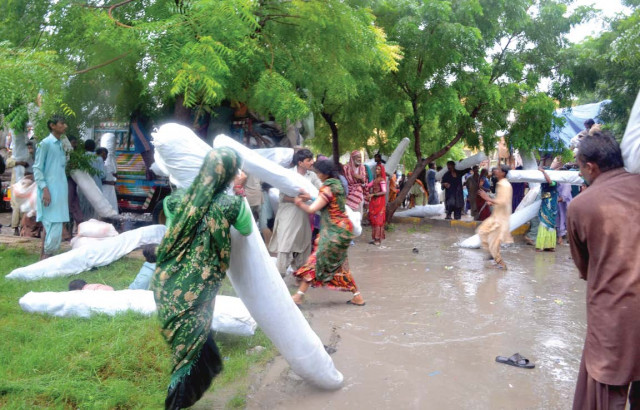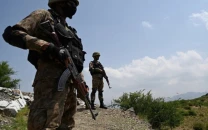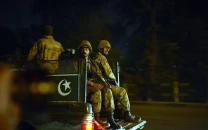2011 floods: Sindh submerged in flood of miseries
Government struggles to provide relief to the affected areas, taking plea that it was ill-prepared for the calamity.

2011 floods: Sindh submerged in flood of miseries
Torrential downpours across Sindh showed no signs of letting up on Monday, with many parts of the province entering their tenth straight day of heavy rains, causing water levels to rise in many districts and making the job of rescue workers even more difficult. For its part, the government struggled to provide relief to the affected areas, taking the plea that it was ill-prepared for the calamity.
Once again the government spread its hand out to potential donors, but with mixed results. Most donor countries are not impressed with Pakistan’s consistent desire to have others bankroll their relief efforts while the country’s own elite evade taxes and the government splurges money on populist programmes. What is more worrisome is that the government is still unable to fully estimate the extent of the damage or coordinate relief efforts.
The numbers from the flood’s devastation are staggering. An estimated 5.3 million people have been affected, about 1.2 million homes have been washed away and 1.5 million acres of cropland have been inundated. The Sindh government claims to have put an estimated 280,000 people in nearly 2,000 refugee camps.
The death toll from the rains continued to rise, with another 23 people being killed over a 24-hour period, taking the total fatality count above 200 in Sindh according to some sources, though government officials cited a lower figure.
(Read: Floods —Pakistan needs help)
The fatalities occurred due to both diseases as well as drowning, though at least one person was reported killed by a lightning strike.
Government coordination
Addressing a press conference in Islamabad on Monday, Qamar Zaman Kaira, a member of the National Assembly and the spokesperson for the ruling Pakistan Peoples Party, said that the government was coordinating its rescue and relief efforts between federal and provincial levels as well as with the military.
Prime Minister Yousaf Raza Gilani has formed a Flood Relief Committee to coordinate all relief efforts. The committee includes the chairman of the National Disaster Management Authority (NDMA), the cabinet secretary and the personal secretary to the prime minister (two of the three senior-most civil servants in the country) as well as several members of Parliament.
The government claims that the floods this year are worse than those last year, which had inundated over one-fifth of the country’s land-mass and affected about 20 million people. The current flood seems far more concentrated in Sindh.
Senior government officials said that so far, only the government is providing any rescue and relief, with very few non-governmental organisations or international agencies providing any assistance, though UN officials met on Monday with President Asif Ali Zardari to help begin coordinating some of the international relief efforts. The cold response comes not for donor fatigue, say observers, but from questions being raised over the government’s ability to raise a portion of the funds.
(Read: Who is in charge? - Aid crisis as agencies confused)
The picture on the ground is that of mixed success at best. The government claims to have provided relief supplies in many parts of Sindh, but allegations of favouritism, nepotism and inefficient distribution have continued to emerge.
Upper Sindh
In Khairpur, for instance, the government has been able to provide relief goods to only five of the more than 600 villages affected. According to local sources, the government had claimed that it supplied 26 pumps to drain the water from the area, but only three have been seen functional, with the whereabouts of the remaining 23 unknown. The government has continued to supply fuel for all 26, however.
With a large amount of stagnant water in most parts of the district, several sources say an outbreak of malaria and other epidemics could emerge. There are several cases of death by snake bite but serum is rarely available. The government is providing mosquito nets, but it is feared that not nearly enough are being distributed and that the nets themselves may not be enough to prevent the outbreak of diseases.
Khairpur has been particularly badly hit by the floods, with three out of the four tehsils in the district under water, including one (Nara) inundated completely. Only one union council in the entire district is reported to have been completely unaffected.
Government officers charged with responding to public queries and coordinating rescue efforts were unreachable when contacted by The Express Tribune. In some places, the officials placed in charge of responding to queries were present but did not have any details to provide.
Lower Sindh
The rains in lower Sindh continued to hammer most districts, including Badin, one of the poorest regions in the entire country. Hyderabad, Badin, Sanghar, Mirpurkhas, Matiari, Tharparker, Thatta, and Tando Muhammad Khan continued to see water levels rise as the rains continued with no sign of letting up.
(Read: No respite from the rain)
The Meteorological Office said that it expects the heavy rains to last for another three days before slowing down.
The government, meanwhile, continued the evacuation of Badin district, with government personnel being deployed to help rescue people.
“Helicopters will continue to provide aerial surveillance for the rescue effort,” said one officer in the Navy.
The response by the government is in many ways helped by having gone through almost the exact same scenario last year. For example, about 50,000 people who were evacuated from Badin were taken to New Sabzi Mandi in Hyderabad, the same spot that hosted a similar number of people last year.
As the number of refugees continues to rise, the government is forced to move the displaced persons further and further away from their homes. Kazim Hussain Jatoi, a district government official in Hyderabad, said that the government had proposed moving approximately 200,000 people to relief camps in Thatta and Hyderabad from the camps in Badin, which already host more than 75,000 people.
Sanghar
Sindh Chief Minister Qaim Ali Shah finally declared Sanghar district ‘calamity-hit’ after visiting the area and admitting that he had been misinformed about the full extent of the damage in the district.
“The NDMA had placed Sanghar 11th on the list of most affected districts, which trivialised the reality,” said the chief minister in a visit to the district on Sunday night. “The catastrophe in Sanghar is no different than that in Badin, Mirpurkhas and other districts.”
Sanghar, a hub of cotton farming in Sindh with over 360,000 acres of the crop, has seen over 350,000 people displaced, according to Ahmed Baksh Khokhar, a district government official. By September 10, the district had 409 relief camps, hosting nearly 140,000 people, he said.
The district government has demanded Rs100 million from Sindh government for relief and rescue measures. It has already received a Rs280 million grant and another pledge of Rs20 million from the chief minister.
With additional reporting from our correspondents in Islamabad and Agencies.
Published in The Express Tribune, September 13th, 2011.



















COMMENTS
Comments are moderated and generally will be posted if they are on-topic and not abusive.
For more information, please see our Comments FAQ